Originally Published on: Mar 20, 2017
Today is [was, last year in 2017] the transferred Feast of St. Joseph. Yesterday, a Sunday in Lent, “outweighed” the feast.
St. Joseph has many titles in his beautiful litany. We will sing them tonight after our Pontifical Mass at the Throne. Joseph is the Foster-father of the Son of God, Protector of Holy Church, Glory of domestic life.
Speaking of “Glory of domestic life”, I recently saw at the Metropolitan Museum in NYC a marvelous French 15th century limestone relief with painting and gilding produced by the circle of Antoine Le Moiturier (+ c. 1497).
There are charming elements which reveal the devotion of the maker.
The star of the show must be Joseph, rendered in great detail. All the perspectives and points of view favor him, the largest and closest figure.

There are several area which deserve attention. First, on earth, St. Joseph is on the right, warming the little Lord’s coverlet before the fire.
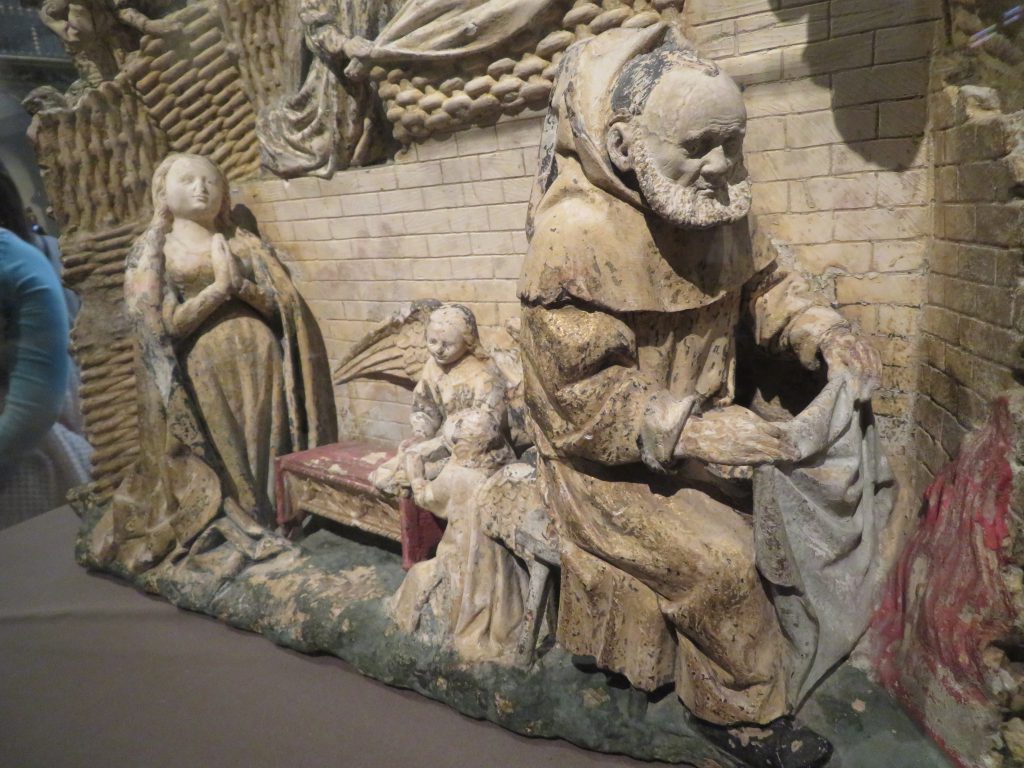
Angels are lending a hand: they make the Infant Jesus’ bed.
Meanwhile, shepherds have scaled a nearby tree. They peer in over the broken wall and crumbled woodwork. They scrabble over each other for a good look.
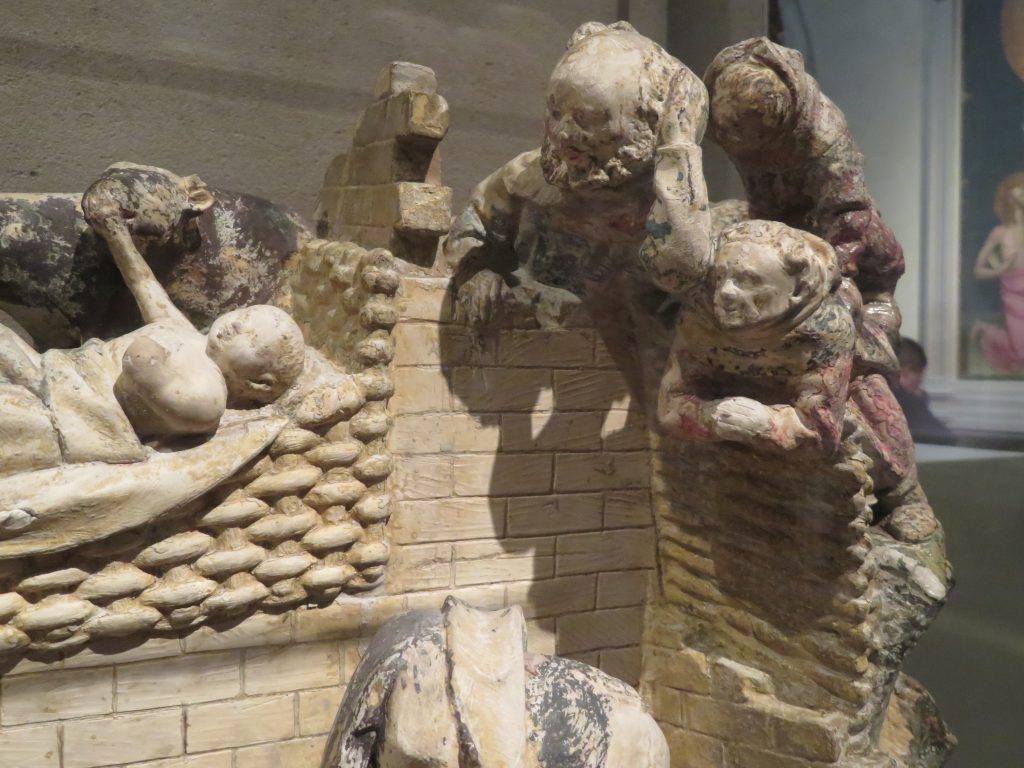
In the center, an angel has raised the Lord up to the loft or rooftop.
He seems to be changing Jesus, while He plays with the muzzle of a curious critter.
The other beast seems either to want to help or she is trying to eat the blanket.
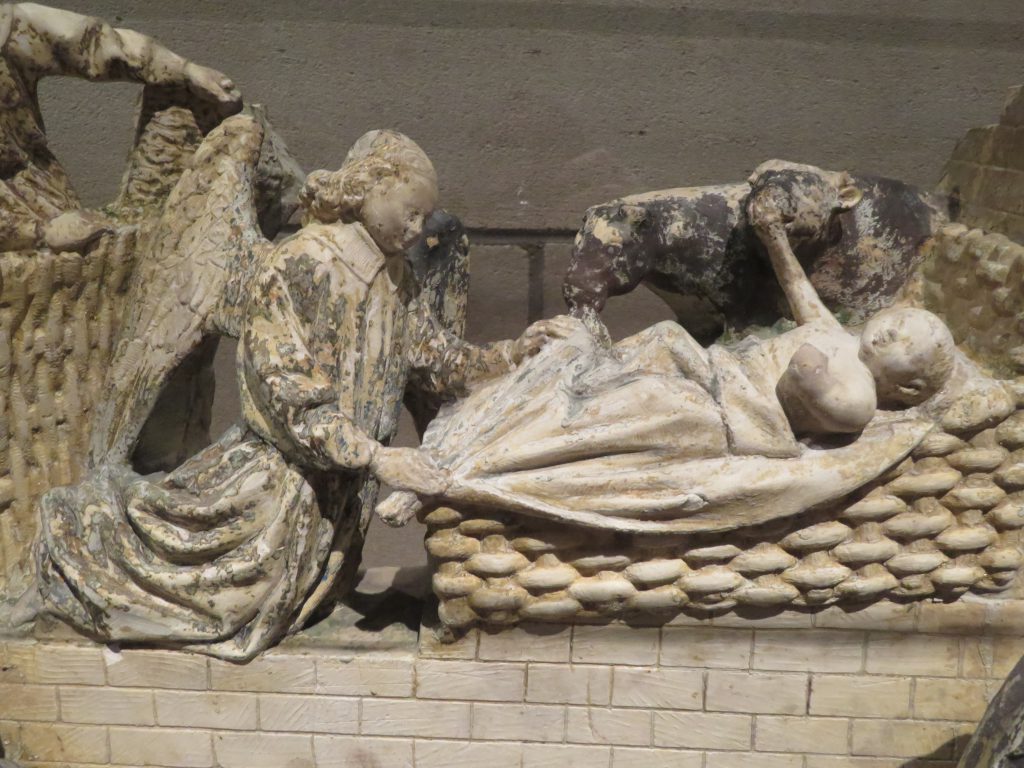
On the left, more angels enthusiastically watch. One of them, perhaps our designated representative in the scene, prays, overwhelmed, as we should be.
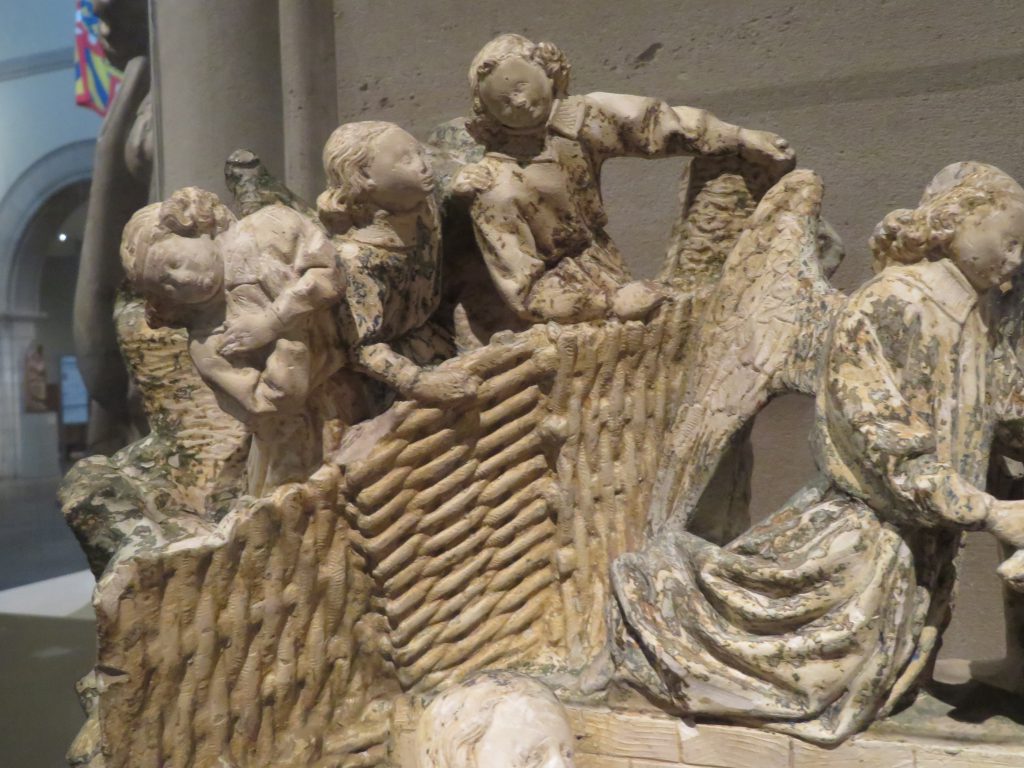
The Mother of God serenely gazes upward towards the domestically challenged angel and her Son.
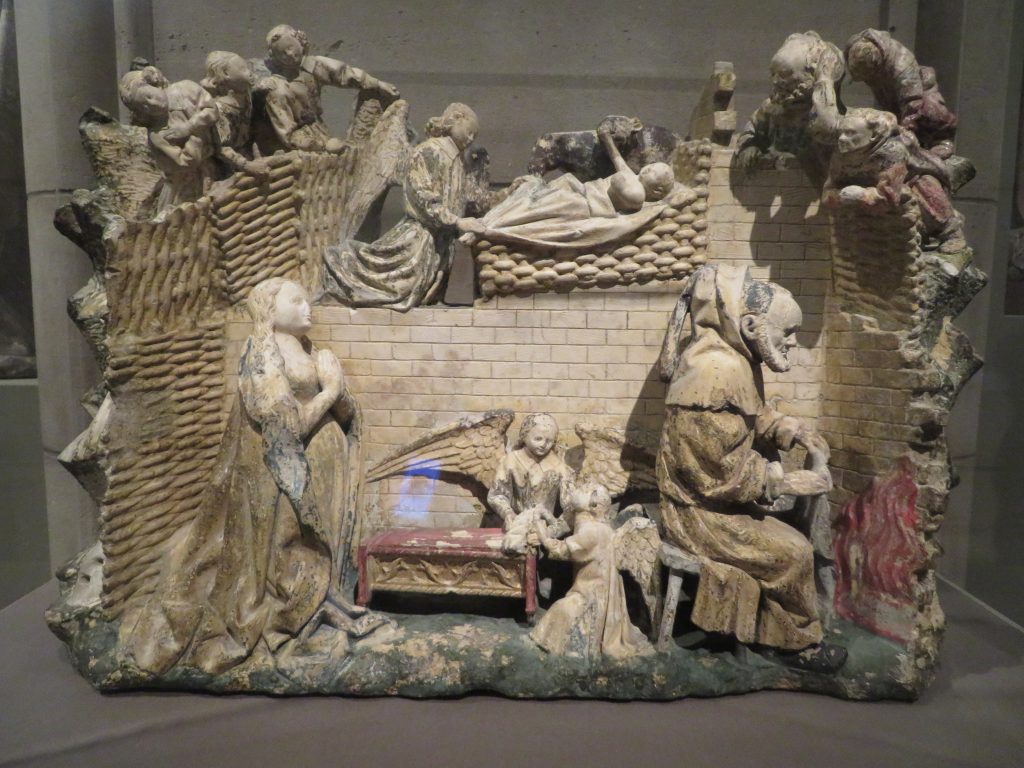
Simply superb. There is a lot packed into this little scene, which is about a foot and a half wide.
Great love made this.
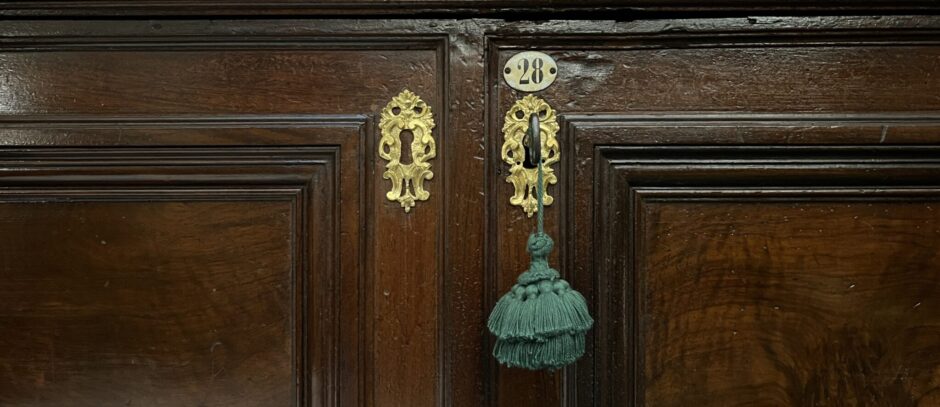

































Great love, great talent. Thanks for sharing it!
What a beautiful depiction in a day of the life of the Holy Family. Thanks for sharing this, Father.
Aww, lovely indeed! I think the “curious critters” are the ox and the donkey. The Jesus Child is lying in their manger and is being swaddled by an angel. Other angels are preparing a much more royal bed for the new king.
Father Z, is that your bent over figure in the shadows cooking Chinese…
For some reason, the detail of the face of St. Joseph makes me think the artist modeled him after a person he knew.
And notice that St. Joseph is depicted as an old man, befitting the account in the Protoevangelium of James. In that account, Mary was dedicated to the Lord, and was raised in the Temple. When she came of age and it was no longer appropriate for her to live with men, a guardian (much older, of course) was to be chosen for her. As Joseph was being considered, his staff bloomed as the sign of God’s approval. To this day, Joseph is frequently portrayed in art as an old man.
Tantum Ergo writes:
“And notice that St. Joseph is depicted as an old man, befitting the account in the Protoevangelium of James. In that account, Mary was dedicated to the Lord, and was raised in the Temple. When she came of age and it was no longer appropriate for her to live with men, a guardian (much older, of course) was to be chosen for her. As Joseph was being considered, his staff bloomed as the sign of God’s approval. To this day, Joseph is frequently portrayed in art as an old man.”
Recently in the Catholic blogosphere there has been an uptick in people favoring an elderly St. Joseph. They say it’s more traditional, and that the “younger St. Joseph” of more recent iconography is part and parcel of an ever-exaltation of St. Joseph. These critics frequently cite the apocryphal Protoevengelium of James. Here, I think it’s good to keep in mind the following argument offered by Phillip Bellini in the article “Was St. Joseph Previously Married?” (https://www.catholicculture.org/culture/library/view.cfm?recnum=9298):
“Let’s get right to the facts. The only sources for the age of St. Joseph are the apocryphal accounts previously quoted. They are just as unreliable in this instance too. The apocryphal stories were not meant to portray Joseph as old and senile, but basically to safeguard the universal belief in Mary’s virginity in the face of heretical opposition and insinuations. They adopted old age for Joseph to symbolize deadened passions, and to certify Mary’s absolute continence with Joseph. Again, they made “brethren of the Lord” children of a former marriage to avoid problems. So they had to give Joseph advanced years to generate these children, then to become a widower, and only after that period to take Mary into his charge as her guardian.
When this unfounded supposition is rejected, we will have more reason to justify his youth at the time of his marriage with Our Lady. Also, to reply to the apocrypha on his senility, I reject it because it was so unique a marriage as ever existed between two people so holy as Joseph and Mary. God’s grace is more than sufficient to observe virginity if such be God’s will.
Above all, the idea that St. Joseph would be an old man of eighty or more years stands in direct contradiction with the requirements of his vocation. Joseph was to appear publicly as the husband of Mary and the father of Jesus, at least to safeguard the honor of Mother and Son. Yet how could a man of patriarchal years be considered capable of fatherhood? A decrepit, senile guardian of Mary would open the door to public suspicion of adultery and illegitimacy. Again, hard work and trying situations of all sorts beset the Holy Family. How could such an old man perform duties that called for a robust provider and protector? The general feeling of the Gospel points to the conclusion that Joseph was of an age customary for marriage, and that age was certainly not advanced to the twilight years of life. Granting the truth of St. Joseph’s virginity, and therefore the falsity of any tales of his earlier marriage, could we hold that a devout Jew would remain unmarried until extreme old age in defiance of the customs of his day? We have to assume that Joseph lived during the major portion of Christ’s life at Nazareth, as would appear from the text of St. Luke, “He was subject to them.” (Lk.2:51)
Therefore it is safe to assert that Joseph must have been espoused to Mary when he was in the prime of life.”
So the fact that St. Joseph is presented as elderly here represents an artistic tradition rooted in the apocrypha. The apocryphal account of his age likely results from over-anxiety to preserve the Virginity of Our Lady. Instead of rooting that virginity in divine grace offered to Our Lady and St. Joseph by God, the apocryphal author rooted that virginity at least partly in St. Joseph’s supposedly decrepit nature. If you think about it, if Our Lady was supposed to have a guardian, how long was she supposed to have him for? Five to ten years, then another elderly man for five to ten years, on down the line? Or would it make sense to find for her a younger man who could actually support and guard her, likely an ascetic who had himself made a vow of celibacy?
How excellent. Thank you for this, Father.
My, my! Whoda’ thunk such a charming story from the Protoevangelium of James would elicit such a response? Nobody ever suggested that St. Joseph was, “senile,” “decrepit,” or ” an old man of eighty or more years”. Of course no one knows, but a somewhat elder St. Joseph (maybe 40’s or 50’s) cannot be easily dismissed as implausible. One thing is certain: St. Joseph was not at Calvary.
Tantum Ergo
“Whoda’ thunk such a charming story from the Protoevangelium of James would elicit such a response?”
I’m not objecting to the story of the blossoming staff, etc. I’m objecting to the insistence that he was old. Whether you are aware of this or not, some in the Catholic blogosphere have been rather insistent on St. Joseph being old. They cite the Protoevangelium, which is apocryphal. Also, you would need to read the article I cited to get the point about senile/decrepit. The point of making St. Joseph old in the apocryphal account — as you yourself admit — is to choose someone beyond child-begetting years. That is a form of decrepitude. One meaning of “senile” is just “geriatric.” And yes, some apocryphal accounts do make St. Joseph about 80 at the time of the Incarnation. I agree that St. Joseph was not at Calvary. If he was in his 30s at the time of the Incarnation, he would have died in his 60s.
How delightful! Heartwarming examples of the human touch throughout the piece. There are terrific examples out there of meadevil sculptures/carvings of smiling angels, grinning and/or baudy gargoyles, manuscripts with playfull doodles, etc. most definitely NOT the dour, miserable era we are sometimes led to believe. Lol, “….the domestically challenged angel…” Great article, Fr.Z!
All: Sure, the Joseph figure, highly defined, looks older.
So what?
Look at the whole piece. It’s a treasure. And what Joseph is doing is wonderful.
Thank you, Father Z, for posting this, with such detailed images. What struck me is the contrast with the older, early medieval tradition which had usually presented the figures of the Holy Family, the angels, and the shepherds in a much flatter, stiffer manner – almost like cartoon figures in their very conventional poses (but, of course, much more detailed and decorated than what we think of as modern-day cartoon figures.)
Here, by contrast, the human figures especially are very *human*: the serenely intent and benevolent expression on Saint Joseph’s face assures one of his devotion to his charges. And the leaning postures of the shepherds nearest to the Infant’s head could convey an impression that these simple fellows have been on the scene for quite some time and have begun to make themselves at home, relaxed into an attentive but informal attitude that one might find among a clutch of men of any century, who have gathered for an informal chat during a wedding or a festival.
And their “right at home” attitude is to invite the viewer, I think, to make himself or herself right at home, too, in the presence of the Child, the Madonna, and their provider and protector, Saint Joseph.
tradition4all,
There is of course no firm, reliable information on St Joseph’s age at the time of the B.V.M.’s betrothal, leaving us with no clarity in this world; but the overwhelming tradition up through the Middle Ages was that of an older St. Joseph. There is nothing to keep one from portraying him either way (or certainly so movingly as he is depicted here), but there’s more support, such as it is, for an older St. Joseph than there is for a younger one. The Counter Reformation Era, in fact, had its own vested reasons for an increased push for depicting St Joseph at a younger age: http://theradtrad.blogspot.com/2015/09/josephology-part-13-propaganda-machine.html
Thanks to Fr Z for one of the most moving depictions I have ever seen of St. Joseph. Very powerful, and very human.
As noted, we have no definitive basis for saying Joseph was older; of course we likewise cannot definitively attribute to him a young age. I’ve never thought it particularly helpful to suppose that his age would account for his chastity, given that age is hardly any guarantee of such things anyway; and only modernity supposes such a thing to be out of reach for any of us. Of course, a hormone-laden teenaged Joseph would doubtless have received the necessary graces from God, but this cuts both ways: an old Joseph could have received whatever strength he needed to fulfil his role. (Not to mention having greater experience and wisdom.) Likewise, arguments about step-brothers vs. cousins are not especially compelling one way or the other.
However, to suggest (as in the linked article) that St. Joseph must have got married at the “usual” age is surely a weak argument. If there’s one thing we can definitively say about him, it is that he was no usual man. I think the most interesting point to note is that Joseph apparently died before Jesus began his ministry. If he were a youth, like Mary, then he would have barely been fifty, which is too young to die. Could he have not been ill? Of course, but St. Joseph died in the arms of Jesus and Mary (which is why we invoke him as the patron of a holy death) — if merely to touch our Lord’s cloak could heal one, then it seems unthinkable that Joseph could have lain ill in His embrace and remained sick.
Obviously, God is under no obligation to provide miracles for anyone, not even St. Joseph; but it strikes me as far more likely that he got his prescribed three score and ten. If he died at age 70, then he would have been at least 40 when Jesus was born; given the “customs of his time”, it is therefore likely (though again, Joseph was not typical!) that he would have been already married with adult children.
Great love, indeed!
This is one of many pieces of Catholic art that I wish I could visit in a church and not a museum. It is beautiful.
[Foster the sacred arts.]
I add the Litany of St. Joseph to my Sunday Rosary, for the intention of the Universal Church, whose patron he is. We could really use his help right now.
Age? All I know if I had to carve that by hand-by my self- i’d be really old.
@Ttradition4all:
From Von Speyr, Adrienne. Handmaid of the Lord: 2nd Edition 2017 (pp. 64-66). Ignatius Press. Kindle Edition.
But one cannot say that she had with certainty expected children from Joseph. In such an expectation, as in a vow of virginity, she would have determined something in advance. There would then have been two expectations in her soul that would not in every case have been apt to form a unity: an earthly expectation, such as that of every normal bride, and another that God gives her and that can only be fulfilled by him. Mary lives beyond this decision: for her the decision for marriage is not a decision against virginity, and the decision for the lay state is not a decision against the state of perfection. She does not reflect upon their compatibility. She knows only one rule, which she follows without any swerving, stopping, or turning back: to do the will of God perfectly in everything. Her life runs along a straight path, without detours, that leads from the Immaculate Conception to the betrothal, to assent to the angel, to the Nativity, and to the Cross. In this she shows that she is not subject to the law of original sin. For in Paradise there would not have been two mutually exclusive states: bodily fruitfulness would not have been opposed to consecrated virginity.[1] Instead, the spiritual fruitfulness of spouses in God would have been so great that it would have become both the prerequisite and the cause of physical fruitfulness and would in no way have impaired spiritual or physical integrity.
For Joseph everything is different. He is subject to the law of original sin, and he cannot help noticing the contradiction between the married state and virginity. The betrothal is for him a prelude to a normal earthly marriage. He is chaste and just; he lives in the spirit of justice inherited from his fathers. His chastity has nothing to do with the lackluster impotence that most pictures seem to give him. If he will have to make a renunciation, then his whole manhood will achieve it and will thereby be strengthened in its very masculinity. The intensity of his renunciation will give him the strength to keep growing within his mission. He will not stand languishing next to Mary; instead, he will stand beside her as a man who knows his strength but has sacrificed it in simplicity and generosity. His renunciation is made with strength and intensity and then forever concealed in silence. Everything is so thoroughly in order and so complete that the matter need never be spoken of again.
In the betrothal, however, he experiences real feminine love, and this love of his bride enriches him as only feminine love is able to fulfill a man. In the light of this love, he sees before him the life that he is to shape for his family as the husband. He has chosen marriage in freedom and responsibility, and he will receive from God marriage and not the religious life. And within the married state God will impose abstinence on him. He is not removed to a cloister for this. He lives in his house with wife and Child, outwardly indistinguishable from other married men. In the midst of the world, he must learn abstinence.
[1] A great number of Fathers of the Church and medieval theologians are of this opinion.-HANS URS VON BALTHASAR Back
Von Speyr, Adrienne. Handmaid of the Lord: 2nd Edition 2017 (p. 203). Ignatius Press. Kindle Edition.
US HERE – UK HERE